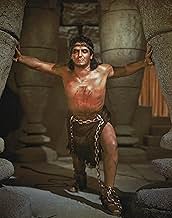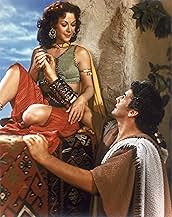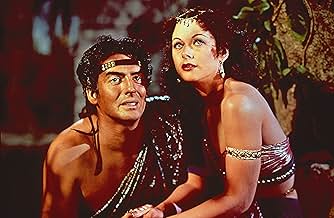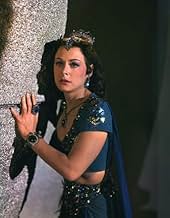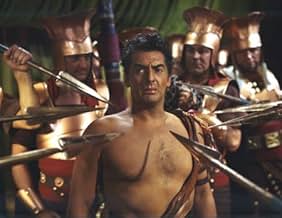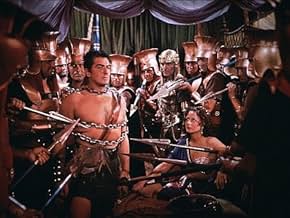VALUTAZIONE IMDb
6,8/10
9589
LA TUA VALUTAZIONE
Quando l'uomo forte Sansone rifiuta l'amore della bella donna filistea Dalila, lei cerca vendetta che porta conseguenze orribili di cui entrambi si pentono.Quando l'uomo forte Sansone rifiuta l'amore della bella donna filistea Dalila, lei cerca vendetta che porta conseguenze orribili di cui entrambi si pentono.Quando l'uomo forte Sansone rifiuta l'amore della bella donna filistea Dalila, lei cerca vendetta che porta conseguenze orribili di cui entrambi si pentono.
- Regia
- Sceneggiatura
- Star
- Vincitore di 2 Oscar
- 7 vittorie e 5 candidature totali
Russ Tamblyn
- Saul
- (as Russell Tamblyn)
Francis McDonald
- Story Teller
- (as Francis J. McDonald)
William 'Wee Willie' Davis
- Garmiskar
- (as William Davis)
Kasey Rogers
- Spectator
- (as Laura Elliot)
Recensioni in evidenza
This film is a must for everyone who loves Technicolor, great actors and great movies. Mature is a wonderful Samson but Hedy Lamarr is the definitive incarnation of beauty. She is also a very good actress and directed by De Mille gets her screen triumph. Watch this over and over again and you'll not be tired.
While having some very major flaws, this is a thoroughly decent biblical epic on the story of Samson and Delilah. It is nicely filmed, with lovely costumes, nice sets and good cinematography and has a rousing score. Also the acing is not bad at all, Victor Mature is a dashing Samson and Hedy Lamarr pretty much steals the film as the beautifully captivating Delilah, it somehow reminded me of Rita Hayworth in Salome. George Sanders proves here he is the epitome of calculation and world-weariness, and while Angela Lansbury is good she has been better. Plus the final scene with the temple coming down is brilliantly staged and serves as the highlight of the film. However, the script is not always that great, neither is the pacing which is quite slow or the direction which is disappointingly stodgy. Overall though, Samson and Delilah isn't bad, it could've been better, but it was decent. 7/10 Bethany Cox
Cecil B. DeMille is best remembered for his biblical epics, even though in a forty-year, eighty-film career he only made four of them. It wasn't just that the bible pictures gave him some of his biggest hits; it was in these features that DeMille seemed most at home, and the one genre in which he had unique ability.
Samson and Delilah brought an end to a long phase of epic-cum-adventure movies from DeMille. This period, beginning with The Plainsman in 1936, had some of the weakest pictures of his career for a number of reasons. For one thing, DeMille was not really very good at individualistic action scenes, and there was too much DeMillean historical grandeur and not enough of the free-spirited feel of the Errol Flynn or Tyrone power swashbucklers he was to some extent an trying to copy. What's more, these were mostly original stories or, at least, ones which were not well known, and DeMille's poor choice of source material and screenwriters meant the new characters and situations tended towards the feeble. DeMille's strength lay in his staging and presentation of a familiar tale, and as such his return to Sunday-school moralising, stuffy and pompous though it may be, is apt and welcome.
You see, DeMille was probably aware on some level that although these fables were well-known in a largely Christian society, to a modern audience they were also historically distant, emotionally neutral and even ridiculous when presented literally. But DeMille never attempted any humanity or realism in his features, instead turning the remote, mythical nature of the stories into a virtue, portraying his subject matter with a kind of dignity and grace. Of course most ancient world epics do this to some extent, but DeMille did it the most effectively because he never demanded that the audience sympathise with the characters, merely that we marvel at their deeds.
Specifically, DeMille composes the picture with overstated gesturing and painterly tableau, like a Gustave Dore print come to life. This is combined with the vivid colours of a bible stories illustration, coded with drab shades for humbleness and virtue, garish ones for extravagance and sin. Throughout, DeMille's flair for dreamlike, rhythmic motion keeps the images flowing, most notably in the establishing tracking shot at the wedding feast - although if you watch closely you'll see one of the two men engaged in a mock swordfight is actually camply slapping his opponent with a feather duster.
And DeMille was perhaps unique in that he even used the imagery to turn God into a character. You can see from one of his much earlier religious pictures, 1929's The Godless Girl, that DeMille associated God with natural beauty, and in Samson and Delilah God makes several key "appearances" as a breathtaking skyscape. This touch would be expanded upon in the 1956 version of Ten Commandments.
It's a pity DeMille didn't associate God with good acting, because even the theatrical presentation on offer here could do with at least some half-decent hamming. The trouble is DeMille chose his actors for their physicality, not for their ability to qualify their job description. In this respect Victor Mature and Hedy Lamarr are natural choices. DeMille's business associate Henry Wilcoxon, whom the director unbelievably used to cast in lead roles, is as wooden as ever, and the somewhat hit-and-miss Angela Lansbury, misses this time. The only standout is George Sanders who proves, just as Herbert Marshall did in DeMille's Four Frightened People, that bad dialogue becomes bearable if you underplay it.
Fortunately when it came to crew DeMille always procured the best. Samson and Delilah boasts Oscar-winning costumes and art direction from no less personages than Edith Head and Hans Dreier respectively. The Technicolor cinematography is great, with some remarkably clear night time shots. Some of the effects may be a little dubious; whenever Victor Mature lifts up something heavy it's obvious it's being hoisted from offscreen, and that woolly-rug/lion tamer scene is actually betrayed by bad editing, but overall this is a solid, high-quality production.
Yes, Samson and Delilah is as corny as anything, but it looks great, and above all it entertains. Don't be too harsh on DeMille's staginess or his archaic moralism, for as his willing appearance as himself in Sunset Boulevard proves, he probably didn't have a sense of irony. And his earnestness was probably his greatest asset.
Samson and Delilah brought an end to a long phase of epic-cum-adventure movies from DeMille. This period, beginning with The Plainsman in 1936, had some of the weakest pictures of his career for a number of reasons. For one thing, DeMille was not really very good at individualistic action scenes, and there was too much DeMillean historical grandeur and not enough of the free-spirited feel of the Errol Flynn or Tyrone power swashbucklers he was to some extent an trying to copy. What's more, these were mostly original stories or, at least, ones which were not well known, and DeMille's poor choice of source material and screenwriters meant the new characters and situations tended towards the feeble. DeMille's strength lay in his staging and presentation of a familiar tale, and as such his return to Sunday-school moralising, stuffy and pompous though it may be, is apt and welcome.
You see, DeMille was probably aware on some level that although these fables were well-known in a largely Christian society, to a modern audience they were also historically distant, emotionally neutral and even ridiculous when presented literally. But DeMille never attempted any humanity or realism in his features, instead turning the remote, mythical nature of the stories into a virtue, portraying his subject matter with a kind of dignity and grace. Of course most ancient world epics do this to some extent, but DeMille did it the most effectively because he never demanded that the audience sympathise with the characters, merely that we marvel at their deeds.
Specifically, DeMille composes the picture with overstated gesturing and painterly tableau, like a Gustave Dore print come to life. This is combined with the vivid colours of a bible stories illustration, coded with drab shades for humbleness and virtue, garish ones for extravagance and sin. Throughout, DeMille's flair for dreamlike, rhythmic motion keeps the images flowing, most notably in the establishing tracking shot at the wedding feast - although if you watch closely you'll see one of the two men engaged in a mock swordfight is actually camply slapping his opponent with a feather duster.
And DeMille was perhaps unique in that he even used the imagery to turn God into a character. You can see from one of his much earlier religious pictures, 1929's The Godless Girl, that DeMille associated God with natural beauty, and in Samson and Delilah God makes several key "appearances" as a breathtaking skyscape. This touch would be expanded upon in the 1956 version of Ten Commandments.
It's a pity DeMille didn't associate God with good acting, because even the theatrical presentation on offer here could do with at least some half-decent hamming. The trouble is DeMille chose his actors for their physicality, not for their ability to qualify their job description. In this respect Victor Mature and Hedy Lamarr are natural choices. DeMille's business associate Henry Wilcoxon, whom the director unbelievably used to cast in lead roles, is as wooden as ever, and the somewhat hit-and-miss Angela Lansbury, misses this time. The only standout is George Sanders who proves, just as Herbert Marshall did in DeMille's Four Frightened People, that bad dialogue becomes bearable if you underplay it.
Fortunately when it came to crew DeMille always procured the best. Samson and Delilah boasts Oscar-winning costumes and art direction from no less personages than Edith Head and Hans Dreier respectively. The Technicolor cinematography is great, with some remarkably clear night time shots. Some of the effects may be a little dubious; whenever Victor Mature lifts up something heavy it's obvious it's being hoisted from offscreen, and that woolly-rug/lion tamer scene is actually betrayed by bad editing, but overall this is a solid, high-quality production.
Yes, Samson and Delilah is as corny as anything, but it looks great, and above all it entertains. Don't be too harsh on DeMille's staginess or his archaic moralism, for as his willing appearance as himself in Sunset Boulevard proves, he probably didn't have a sense of irony. And his earnestness was probably his greatest asset.
She sure WAS a wildcat in this film! Beauty beyond compare! And Mature's 'Samson' was a sure delight (even though he was told to drop 30 lbs. for the role before filming). Biblical stories are always interesting & enjoyable if filmed in this colorful way, as was The 10 Commandments. We don't need that brown, boring type of color for 'realism'. We want beautiful color to show off those gorgeous costumes & scenery! (When it's not fake back-drops!) Anyway, see this film! It's worth whatever the video costs! Or catch it on TV!
Yeah...so some people may think it's corny and outdated. However, there is something about this movie, in spite of some of the poorer technical gimmicks...yet I still love it. I think that Lamarr does a great job as Delilah and don't understand why some think otherwise.I think she is/was the perfect Delilah..and Mature did a great job as Samson. Sanders was really terrific in his role and Lansbury carried out her part very well also. Call it what you will..but I find it is still worth watching; the color, costumes, Samson knocking down the Temple.. (love that scene!Good special effects for the time.) Whatever it is..I find myself watching it every now and then and still enjoy it as much as when I first saw it..
Lo sapevi?
- QuizFor the scene in which Samson kills the lion, Victor Mature refused to wrestle a tame movie lion. Told by Producer and Director Cecil B. DeMille that the lion had no teeth, Mature replied, "I don't want to be gummed to death, either." The scene shows a stuntman wrestling the tame lion, intercut with close-ups of Mature wrestling a lion skin.
- BlooperA boy in Samson's village is named "Saul." Samson hints or predicts that one day he will be king of Israel. The script states repeatedly that Samson was a "Danite" (member of the Tribe of Dan). The Bible states King Saul was a member of the Tribe of Benjamin and grew up near Jerusalem (not in Dan's territory).
- Curiosità sui creditiAlthough the opening credits mention "Holy Land Photography," the second-unit location shooting occurred in North Africa (Algiers and Morocco), not Israel or the Middle East.
- Versioni alternativePrevious home media releases of the film (LaserDisc, VHS) did not include the overture and exit music. They were restored for Paramount's official DVD release in 2013 and the subsequent Blu-ray release in 2014.
- ConnessioniFeatured in History Brought to Life (1950)
I più visti
Accedi per valutare e creare un elenco di titoli salvati per ottenere consigli personalizzati
Dettagli
- Data di uscita
- Paese di origine
- Sito ufficiale
- Lingua
- Celebre anche come
- Samson and Delilah
- Luoghi delle riprese
- Azienda produttrice
- Vedi altri crediti dell’azienda su IMDbPro
Botteghino
- Budget
- 3.000.000 USD (previsto)
- Tempo di esecuzione
- 2h 14min(134 min)
- Colore
- Proporzioni
- 1.37 : 1
Contribuisci a questa pagina
Suggerisci una modifica o aggiungi i contenuti mancanti



